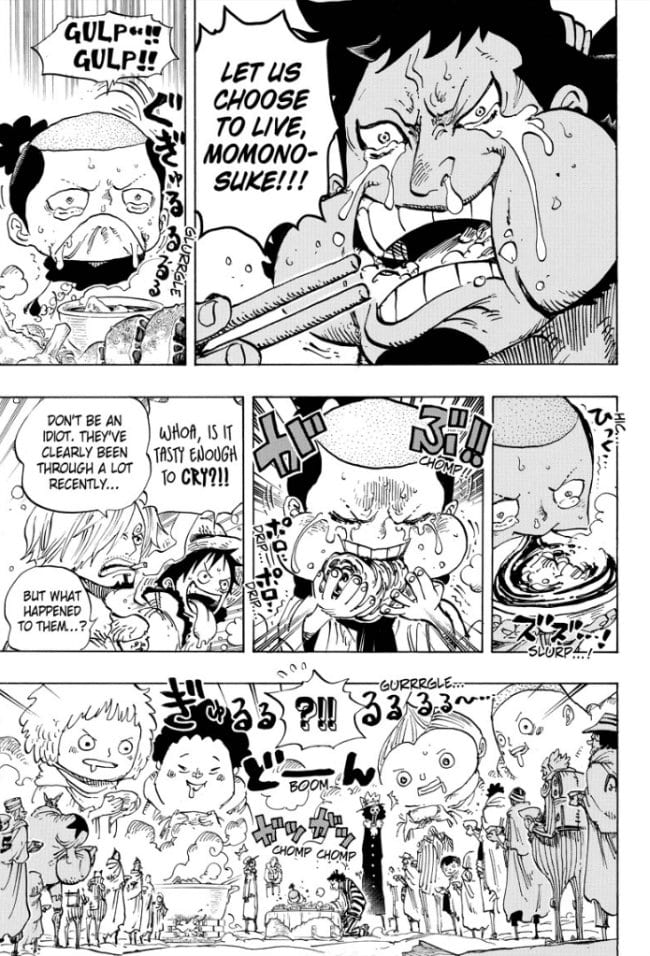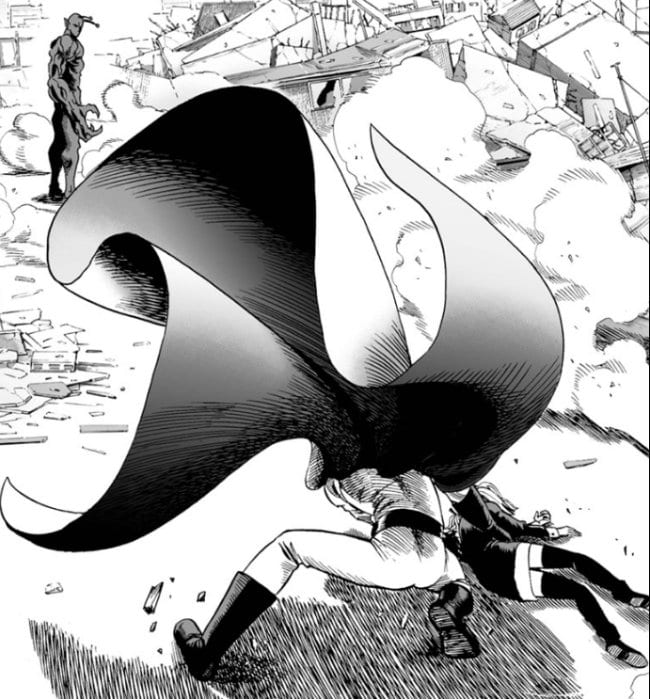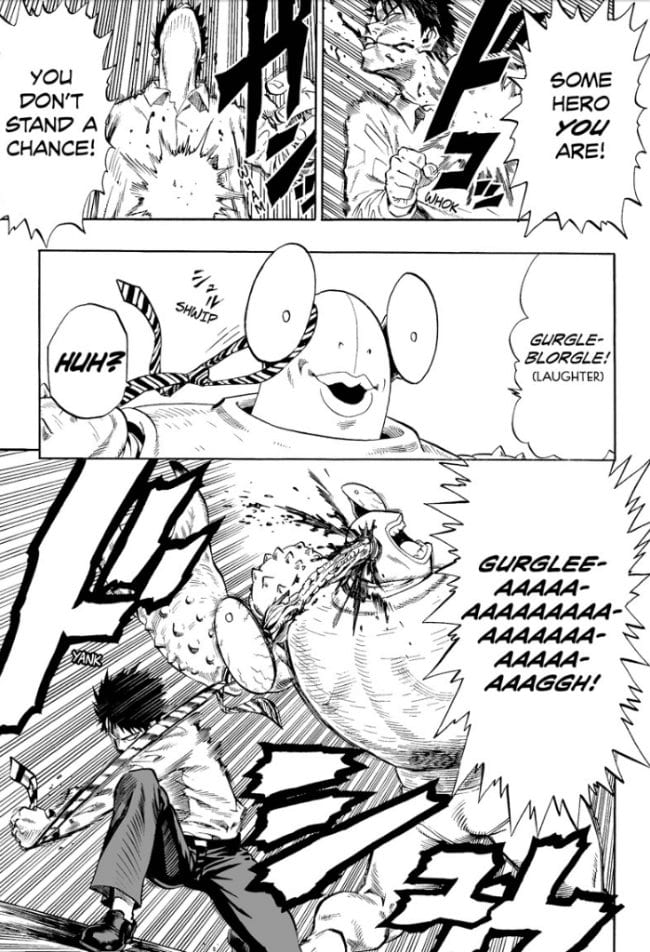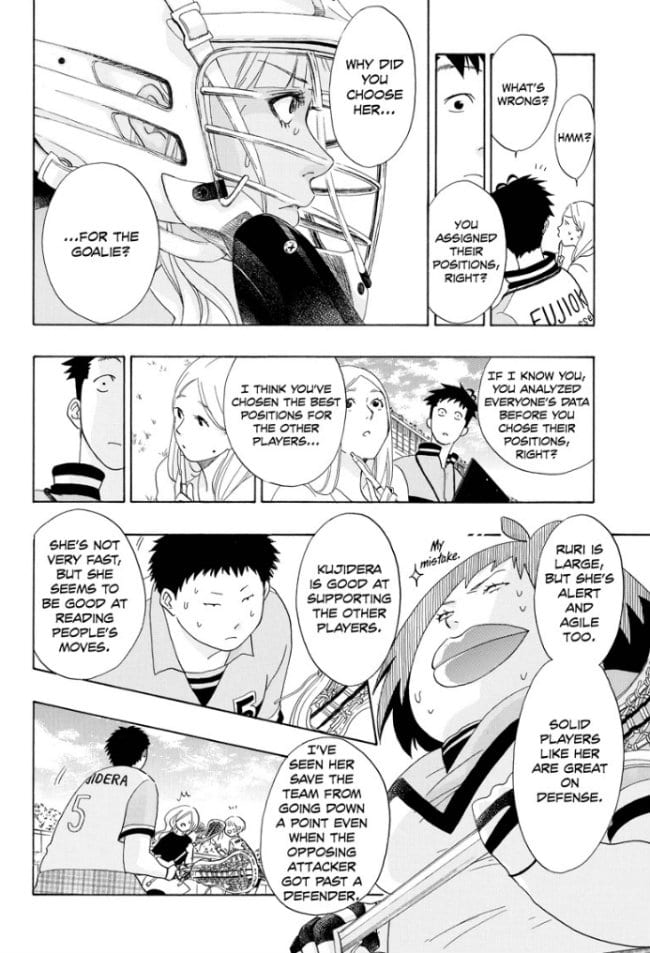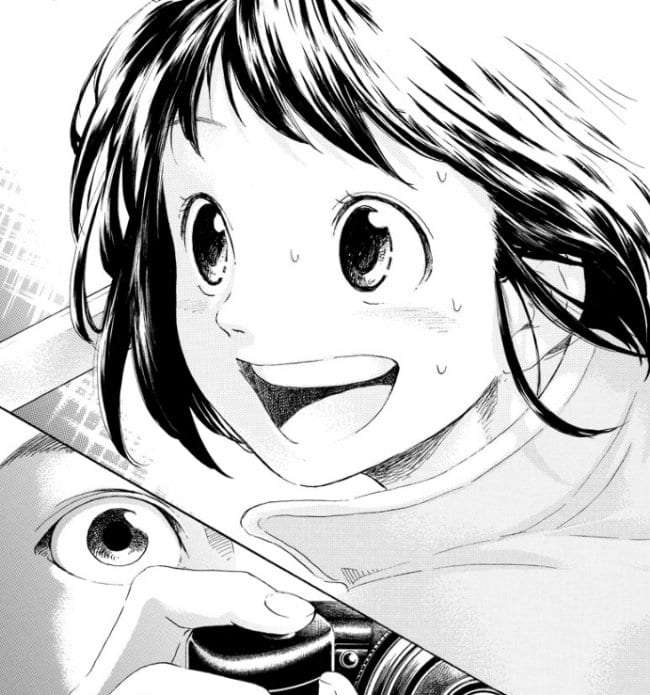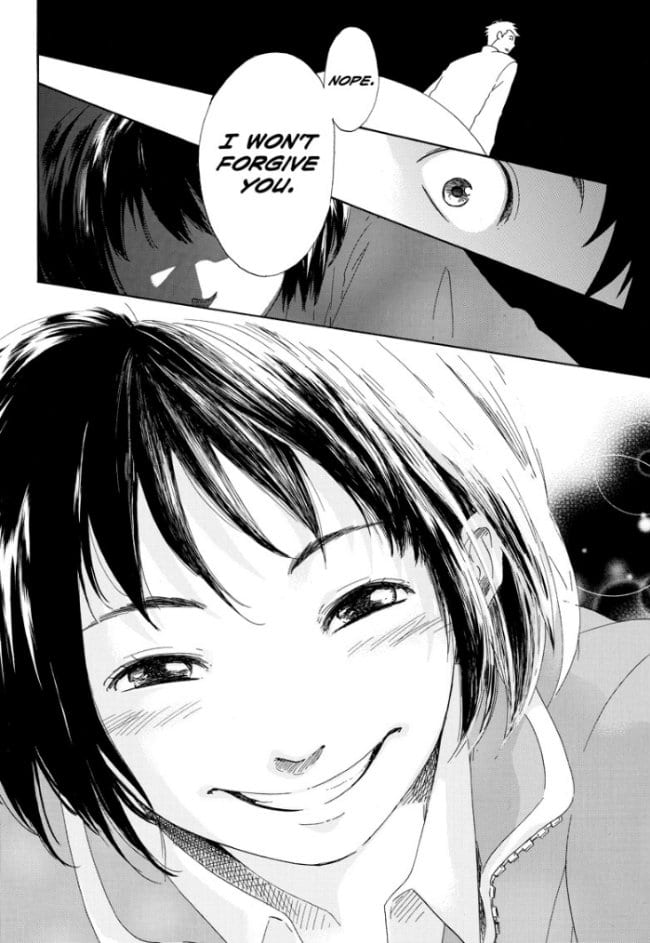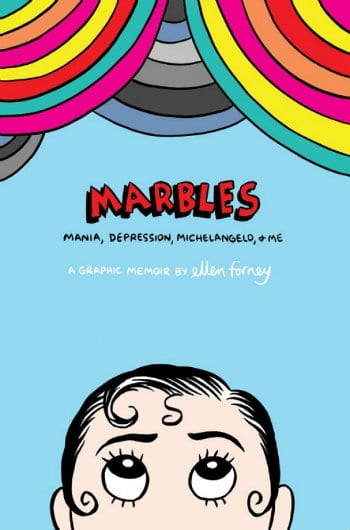Above we see the heart -- if not quite the soul -- of Akira Toriyama's Kintoki, a 30-page one-off comic from 2010, which the revered Dragon Ball creator put together under the auspices of his Bird Studio. It's important, initially, to understand the dual joke in the studio's name: the "Tori" in Toriyama means "bird," forming a classical Japanese pun, while the 'studio' consists almost entirely of Akira Toriyama, in almost defiance of the dozen-handed approach necessary to maintain a weekly serial's pace.
And Dragon Ball, at the height of the six million-copy '90s circulation apex of its home base, the famous Weekly Shonen Jump, was the most popular comic in the world. No wonder Shonen Jump commissioned Kintoki as part of a celebration of "Super Legend" creators, despite the many allegations surrounding the 1995 end of Dragon Ball, which purportedly came a good deal later than the artist would have preferred, supposedly at the behest of parties eager to keep the cash cow grazing. Toriyama never returned to longform comics serialization, but he doesn't seem to have rusted much from looking at Kintoki - it's filled with scraps and jokes and short guys and tough guys and dragons and sassy girls... with a cool dude heroically retiring at the climax, 'cause fight masters die young.
None of this background is present in the comic's new English translation; instead, we get the excitement of its forum, the newly re-titled digital magazine Weekly Shonen Jump, formerly Weekly Shonen Jump Alpha, the successor to the popular, now-defunct English-language print magazine Shonen Jump, manga publisher Viz's westernized approximation of the aforementioned Japanese magazine *also* titled Weekly Shonen Jump (or Shūkan Shōnen Jump, if you insist). The re-title/re-launch/re-boot occurred last week, prompting some new interest in the magazine and its ten English-translated serials, particularly in that those serials were announced to be arriving "SAME DAY as JAPAN," per the screaming ads. Appetites were no doubt further whetted by today's surprise announcement of an eleventh serial: a newly colorized re-release of Toriyama's own Dragon Ball, starting with the popular content known to the West as Dragon Ball Z (i.e. chapter 195 and forward in the ongoing series).
But wait. The Japanese release of the colorized Dragon Ball doesn't appear to be getting serialized anywhere; three collected volumes, in fact, are dropping on February 4, the "SAME DAY as JAPAN" the English serialization starts, ha ha.
Also, most the serials running in the English Weekly Shonen Jump are carryovers from Weekly Shonen Jump Alpha -- which itself carried over most of the content from the print Shonen Jump -- albeit now arriving on the same day as the content hits Japanese shelves, rather than suffering the two-week delay of the Alpha edition. Does that mean the new, piqued reader is supposed to put up with chapters 616, 523 and 685 of series that've been running since the 1990s? Moreover - isn't the Japanese Weekly Shonen Jump, like, 400 pages or something?
Well rest easy, new comics fans! In the manner of a wizened mentor beating the guts out of you on the road to victory -- which is not walked in a day -- I will now reveal three critical truths about this exciting new digital comics launch. Take senpai's hand, little angel.
--
1. Weekly Shonen Jump is not specifically an English translation of the Japanese magazine Weekly Shonen Jump.
In fact, the English Weekly Shonen Jump is a selection of manga series from the Shueisha publishing family that best seem to fit the perception of what "Shonen Jump" represents in North America. Not all of the serials in the English edition are actually from the Japanese Weekly Shonen Jump. Indeed, not all of the serials are even shonen manga.
Most critically, the English Weekly Shonen Jump does not carry nearly as much, nor as varied the content as the Japanese edition, which typically runs over twenty serials; the English edition has ten, soon to be eleven, not all of which, to repeat, are actually Shonen Jump serials. There's a variety of reasons for this, ranging from the difficulty of translating predominantly comedic, often pun-laden humor features, to the simple logistics of wrangling 20+ translations at a time, or even securing licenses for all that material.
Moreover, Viz is quite keenly aware of the expectations surrounding the content of 'youth' entertainment in America vs. Japan, and tends to assiduously avoid associating the "Shonen Jump" banner with potentially edgy content. For example, among the more popular of the newer serials in Japan is Ansatsu Kyōshitsu (Assassination Classroom), a comedic series about an intergalactic being who swears obliteration on the Earth, but in the meantime becomes a junior high school teacher; the story follows his students' attempts to murder him. That's pretty clearly not gonna fly at the moment -- maybe a later moment, but not at launch -- even though the setup strikes me as much more interesting than most of the 'safe' material getting translated.
And that's another thing.
--
2. Weekly Shonen Jump is not especially targeted at you, the new reader.
Among the serials selected for inclusion in the English Weekly Shonen Jump, most have a pre-established presence in English translation. I mean, of course - you can hardly expect to have a "Shonen Jump" magazine without Naruto. Or One Piece. Or Bleach. Or Yu-Gi-Oh! Those are all pretty much compulsory, having been the defining works for the English "Shonen Jump" brand since its establishment around the turn of the millennium, so that takes care of nearly half the potential content right there.
Which presents a problem.
Those are all hugely popular series, centered -- for the most part -- around prolonged action scenes. Most of them, in their years in translation, have fed off one another's popularity in defining what big-ticket manga of the shonen type 'should' read like, since one success in a tricky market naturally begets the promotion of other books that sort of look and feel a lot like the prior success. In other words, these comics all feel an awful lot like one another, and while this 'sameness' would be diluted across the wider array of serials presented in the Japanese Weekly Shonen Jump, they absolutely dominate the English edition.
There is a careful art to managing a manga anthology, to avoid monotony in presenting dozens of ongoing serials targeting the same demographic - the English Weekly Shonen Jump, however, cannot afford this. As a result, a very large part of its identity is linked, inexorably, to maintaining a very popular but rather specific notion of 'shonen' manga, to accommodate the expectations of established fans, who know what they want, without a lot of variation.

Of course, I'm being a bit academic here. Pragmatically, a not-insignificant motive behind taking the English Weekly Shonen Jump simultaneous with the Japanese magazine of the same title is to combat the epidemic piracy that hounds the most popular serials: illegal scanlations by devoted fan groups that heretofore have distributed newer serialized material, free, to online readers, under the rationale that official translations are compromised in terms of speed. Inevitably, the rationale will now shift to the official translations being compromised in terms of authenticity -- or, the content itself being compromised by Viz's tendency to edit out potentially offensive images or text, if, in fact, they're still doing that -- since, at heart, there's a certain percentage of the Naruto and Bleach and One Piece readership that simply will never pay money to read this stuff, but Viz, I suspect, anticipates they can snatch away a certain lucrative percentage of the non-paying fans to the side of the angels.
What this means to the unacclimated reader is a slow, dawning realization that an awful lot of this re-branding effort -- not unlike the myriad relaunches over in superhero territory! -- is effectively a maintenance scheme aimed at appealing to different types of longtime, often lapsed(-from-paying-for-shit) readers. Fire up the tablet and tap the very first issue of the new Weekly Shonen Jump, and what you're gonna find is almost entirely serials smack in the middle of a prolonged storyline, most of them having accumulated so much baggage that the lil' what-you-missed text summaries at the top of each feature seem uniquely facetious, almost mocking.

Granted, Viz has gone through the trouble of packaging a pair of free, 350-or-so-page contextual bundles -- one of them, the slightly out-of-date Weekly Shonen Jump Alpha Origins, devoted to collecting the first chapters of the really old serials (along with some stuff that's not actually running anymore), and another, Free Weekly Shonen Jump Starter Pack V.3, keyed to compiling either the first chapters of the newer serials or the starting points of the most recent storylines for the venerable ones -- which do help a tiny bit, but in the end - you've gotta face the facts: you probably don't know every character in One Piece, you can't name all the chakras in Naruto, and you're never, ever gonna understand the appeal of Bleach.
But that's okay!
--
3. You don't need to read everything in Weekly Shonen Jump
Which is not a fresh or controversial assertion. You never have to read everything in *any* comics anthology you come across (unless it's those back issues of Penthouse Men's Adventure I sent down to Guantanamo Bay).
Oh, I know, I know - but I spent the money!
The thing is, the digital Weekly Shonen Jump does share one key attribute with its Japanese cousin: it's ridiculously fucking cheap. Individual 150+ page issues are $1.00 a pop, and a yearly subscription -- to something like 8,000 pages of comics! -- is $25.99, which is less than a three-month subscription to 2000 AD. Viz can do this, in part, because Shonen Jump is so popular in Japan, but there's a cultural thing going on too.
Manga magazines are typically loss-leaders for book collections of individual serials. They are printed on crummy paper, often crunched together with staples, and blown out the door at fire sale prices to be read very quickly and put out for recycling immediately thereafter. Many readers only follow the serials they like, and either skim or ignore the rest; the money they're paying is less for the magazine as an item than access to the latest developments in the books they'll buy later. I said above there's an art to balancing a manga magazine, but that's less curation than ensuring an unobtrusive skim through the contents. You don't need to treat Weekly Shonen Jump as an editor's personal vision, especially not the partial, calculated English edition. You can excerpt, tour, and disregard, secure in the knowledge that you're giving it all a 100% Authentic read.
In fact, for the purposes of this little introduction, let's say you only want to read half the content. Here's how to get a nonetheless full experience.
--
*One Piece
This is the Dragon Ball of its era, the best-selling manga in Japan, and one of the rare cases where one of the most popular things is actually among the best, at least as far as straight-shot friendship! effort! victory! youth manga for boys tend to go. There's a real difference to Eiichiro Oda's creation, discernible from its very first chapter from 1997. Where Naruto and Bleach pandered adroitly to its imagined target audience of disaffected, weird-feeling adolescents -- not a limiting strategy, since all adolescents feel weird and disaffected -- by introducing their heroes as bad-boy troublemakers possessed of vast, hidden powers, rendering them oh-so-special after all, One Piece posited its Monkey D. Luffy as a boy who super-stretchy Plastic Man powers by accident, learns a ton of valuable stuff from his elders, and works his ass off to even try and become the Greatest Pirate in the World, knowing full well that life, disinclined toward cataclysm or destiny, might just swallow him up as another mediocre village boy.
But he ain't prone to brooding, and neither is Oda, who rejects the angular action comics semi-realism of his contemporaries for a swirling, doodling look suggesting an especially manic Toriyama prone to Disney animation licks, which naturally takes this shit all the way back to Tezuka. Everything in One Piece is perpetually heaving and shouting and moving, which lends a kinetic uniform to Oda's wild variety of character designs - I particularly like his women, who tend to be busty at near-Gilbert Hernandez proportions, yet never once seem leered-at or fetishized. Pure, wholesome stimulus!
Admittedly, One Piece is currently nearing chapter 700 of its ongoing story, but fortune has gifted the new Weekly Shonen Jump with a wild action climax in its first issue, and a damn near Claremontian hang-out chapter in this week's second - a wild feast instead of an all-American softball game, but you'll get the picture. Good loud funnies, this.
--
*One-Punch Man
This, on the other hand, is a new series, but with a weird background - not only is it not serialized in Weekly Shonen Jump, but it's not really a shonen manga, nor even a print manga, hailing instead from a free webcomics bonus section on the website to one of Shueisha's seinen magazines, Weekly Young Jump. 'Seinen,' however, has a lot of different connotations; while ostensibly denoting a comic For Mature (male) Readers, the banner can encompass basically anything from borderline porn to stories aimed at 40-year old salarymen, or -- in the case of some of the material in Weekly Young Jump -- shonen manga with just a little too much sex or violence, or even just plain vanilla shonen manga the editors figure will have a better shot with a slightly older audience.
Also, it's a superhero comic. As in: American-style, capes & tights. A superhero comedy, and also a remake from an earlier webcomic by the scriptwriter of record, "One," whose editors have paired him with a longtime shonen specialist artist, Yusuke Murata of Eyeshield 21. Plus, the series isn't really getting released on the same day as Japan, where it's already up to two collected volumes, but who's keeping track of a lone potential 'all-new' series that Viz can start from chapter one?
Despite all of these odd qualifiers, it's pretty simple to see why One-Punch Man is here - its system of references are pure shonen, from the Toriyama look of its initial villain to its central comedic conceit of a hero that's so over-powered, so far along in the invisible serial of power accumulation of life, that absolutely nothing is a challenge anymore. The newest issue reveals his secret origin, as an unemployed young man who, in his depression, discovers a special talent for rescuing ass-faced children from giant crab beasties. Yet success -- that ultimate goal of every classic shonen hero -- brings him no joy. He's left alone at the top with no drive, and a steady stream of new assignments that obviously will never stop.
It's not too hard to think of it all as a cruel metaphor for the industrial manga treadmill itself, and perhaps such self-reference is what truly makes it seinen... and maybe Viz figures potential American kids are better positioned to process the joke, or at least groove on the funny violence that makes up the real substance of every chapter.
Anyway, I like this a lot so far.
--
*Cross Manage
So, now that we've got the 'classic' serial, and the satiric response to the classic serial, we might as well pick something we just like to stare at.
I'm not sure who the mononominal "Kaito" is -- jusr that he's done some smutty comics in the past -- but he's a really interesting artist in terms of how he distorts perspective around his characters to achieve emotional effects (rather than necessarily dropping everything into chibi mode for jokes, say). Cross Manage is a sports manga, its terribly utilitarian title referring to its hero, the reluctant manager of a high school girls' lacrosse team; it's the only series of its type in the digital Weekly Shonen Jump, and it doesn't stray too far from the most typical story tropes, often pausing the action to educate the readers on the rules and strategies inherent to the game being played.
But unlike the other 'genre exercise' in Weekly Shonen Jump -- the deathly mediocre love comedy Nisekoi: False Love, from Naoshi Komi -- Cross Manage demonstrates a sure command of aesthetics. Notice how Kaito blends wildly realistic characters with obvious cartoon figures - usually an artist would offer some variation on how 'real' characters look for emotional or comedic effect, but this one leaves them be, as if to emphasize the motley mix of personality types the hero must deal with. There's also a certain wistful, melancholic atmosphere to everything, reminiscent a tiny bit of sports manga master Mitsuru Adachi, and while Kaito lacks the older artist's sure cartooning hand he makes up for it in these odd studies of clashing cartoon visual types, as well as the strange energy that tends to erupt in his many emphatic closeups of one of the female leads.
He is good with expressions.
They seem more ready for the tablet format than most.
--
*Yu-Gi-Oh! Zexal
In contrast to all of that, this latest entry in the sprawling, never-ending Yu-Gi-Oh! comics 'n card gaming franchise -- the original creator, Kazuki Takahashi, hasn't drawn it since 2004, and by that I don't mean he uses a ton of studio assistants, I mean he doesn't even sign his name as artist anymore -- is probably the 'worst' comic in Weekly Shonen Jump, though I think it's bad in a way that makes it fascinating.
Basically, Zexal isn't so much a 'real' fight comic -- though it quacks like one -- as one of those syndicated columns you'd see in your daily newspaper discussing Bridge strategy by presenting mock games between Madge and Geoff in insane, impossible-to-follow detail. I don't understand anything in this comic, but not in the way I "don't" understand plot points in Naruto or Bleach; the specifics in those proper fight comics may elude me, but I can always understand 'here is a bad person, here is an epic war.' I can't do that with Zexal; huge chunks of it might as well still be in Japanese, yet the arcane rules of the lucrative card game that's kept it alive offer some weird, obscure grounding -- a skeleton of RULES -- that makes it work, subconsciously, as world-building. What an uncanny feeling to pour over this stuff.
Plus, given that the series is *actually* serialized in the monthly gaming-themed Shueisha magazine V-Jump, you don't have to put up with it every issue.
--
*Toriko
Finally, we get to my favorite serial in the magazine. The work of one Mitsutoshi Shimabukuro, Tokiro is a throwback, and sort of a joke, crossing the '80s macho excess of Fist of the North Star with a cooking manga, positing a world where hukling dudes and their lil' sidekicks hunt down the most dangerous and exotic animals... to see how they taste!
It's amazingly fun stuff, full of boundless imagination, with a flair for fantastical visions and impossible creatures, some of which do a little war-making of their own:


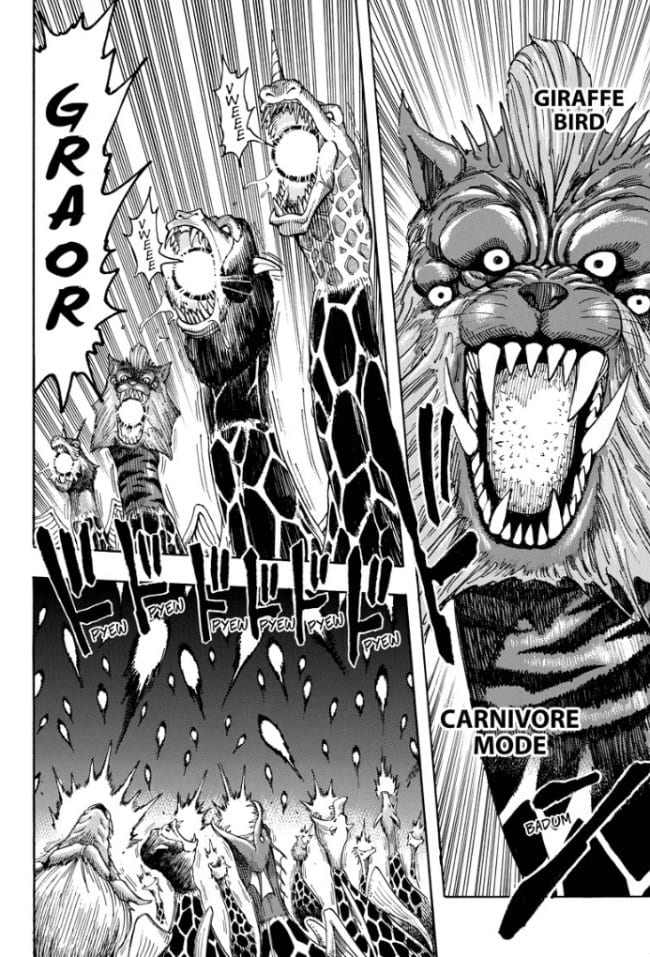
And, appropriately enough, while Tokiro is maybe the most enjoyable of these populist youth manga, it's also the most bad-for-you, the most philosophically troubling. Shimabukuro suggests, in his premise, a world of perfect, happy consumption, where all of society revolves around eating, and everything is *meant* to be eaten. The difference between his heroes and villains are that the heroes do not waste, though they always consume. It's a throwback, then, not only to an older style of action manga, but also to an '80s boom economy that promised the sky and more to Japan - limitless growth, and an endless endless future party, robot cities in space, aloft on the glory of pop.
Now such things are merely part of the aspiration for Weekly Shonen Jump, most broad of all magazines. It's the notion of distant victory, shōri abstracted - knowing a world where once again you can just take anything you want. What a dream! The artist himself knows the reality, having seen his last Shonen Jump serial cancelled after his arrest and conviction for paying a high school girl to perform lewd acts on him - but then, isn't that just part of the consumption? The commercial fantasy? Most of the artists behind these things are made out to look like they care about nothing but making newer and fresher manga for you, True Believer, so I hail this ugly little outburst of fulsome praxis on the young and young at heart - it's a rare honesty for a comic so impossibly big.
***
PLEASE NOTE: What follows is not a series of capsule reviews but an annotated selection of items listed by Diamond Comic Distributors for release to comic book retailers in North America on the particular Wednesday, or, in the event of a holiday or occurrence necessitating the close of UPS in a manner that would impact deliveries, Thursday, identified in the column title above. Not every listed item will necessarily arrive at every comic book retailer, in that some items may be delayed and ordered quantities will vary. I have in all likelihood not read any of the comics listed below, in that they are not yet released as of the writing of this column, nor will I necessarily read or purchase every item identified; THIS WEEK IN COMICS! reflects only what I find to be potentially interesting.
***
SPOTLIGHT PICKS!
The Freddie Stories: Meanwhile, hailing from the all-American weekly serialization platform that is the endangered alternative newspaper funny page, comes the great Lynda Barry, with a fresh 9.25" x 6.25", 180-page Drawn and Quarterly landscape-format hardcover reissue of a 1999 Sasquatch Books compilation of strips from Ernie Pook's Comeek, all focusing on one troubled year in the greatly troubled life of young outcast Freddie. Funny, searing stuff, now expanded with heretofore uncollected installments. Note that this release apparently will not affect Drawn and Quarterly's plans to publish the complete Barry works in their own chronological volumes. Samples; $19.95.
Marbles: Mania, Depression, Michelangelo, and Me: A Graphic Memoir: This has been out for a little while, but not from comic book stores serviced by Diamond, I don't think. It's a new 256-page softcover from veteran alt cartoonist Ellen Forney and Gotham Books, detailing the artist's struggles with bipolar disorder in the smooth lines you've come to expect. As always, these big bookstore-targeted releases carry a risk of getting lost in the noise of Direct Market releases, so keep your eyes peeled. Official site, Tom Spurgeon interview; $20.00.
--
PLUS!
Dear Beloved Stranger: I know nothing about this new Top Self-distributed project from artist Dino Pai, save for the fact that it received one of the very last Xeric grants, making it effectively a self-published work wide-ish distribution. Expect a fable about love, art and understanding. Samples; $19.95.
Hellraisers: A Graphic Biography: Finally, the Peter O'Toole comic of my dreams! What I'd give for a straight comics variant on Loitering With Intent... but anyway, this 160-page UK project from SelfMadeHero instead focuses on O'Toole and fellow actors Richard Burton, Richard Harris and Oliver Reed as they make merry and struggle for the benefit of an invented reader identification figure. From Robert Sellers and the artist JAKe. Preview; $22.95.
Cave~In: Ah, a fine late '90s classic we've got here - and you don't hear "late '90s classic" too often in U.S. comics. But back in '99, Highwater Books took a crack at this wordless exploration of environment and fauna by Brian Ralph, one of the relatively few wide-release books by a Fort Thunder denizen while the Fort itself was still standing. Now Drawn and Quarterly presents a new edition, 96 pages at 4.75" x 6", whereby curious readers can once again experience a relatively user-friendly introduction to the place-driven fantasy documentaries of the scene (after which Brian Chippendale's Maggots and Mat Brinkman's Teratoid Heights await) (provided you can find Teratoid Heights for less than a kidney). Preview; $14.95.
A Treasury of Victorian Murder Compendium Vol. 1: In which NBM presents the Rick Geary omnibus you'd always expected to see, but couldn't buy until now. Three early collections of minute killing research are presented over 228 pages. Samples; $24.99.
Jihad: Also in reissues, Humanoids brings a new 8.5" x 12.3" hardcover edition of a 144-page Igor Baranko project titled The Horde back in 2004 when they last released it, via their short-lived (if quite prolific) partnership with DC Comics. The Journal's Tucker Stone loved this thing back in the day, placing it in the fine tradition of comic book writers "purging themselves of their anger." The plot is a future shock barrage of dictatorial aspirations and visionary questing, the kind of thing poised by its publisher, initially, to ping off the Mad Ideas favored by superhero and sci-fi comics readers of a certain disposition. Still mad today, I'll presume. Samples; $29.95.
Silver Surfer by Stan Lee and Moebius: As far as I can tell, this is a comic book-format collection of the 1988-89 collaboration between writer Stanley Martin Lieber and artist Jean Henri Gaston Giraud. Think of it as Marvel's way of saying "we can publish all the Moebius comics we want, provided they are all this one, specifically"; $7.99.
X-Women: The last time Marvel published Parable, you'll recall, it found itself paired up with thematically similar exploits for the character. Gotta fill those pages somehow, I guess, if you're not going the art book route. Fittingly, Moebius devotee Milo Manara now faces a similar situation, as his sugar-spun collaboration with writer Chris Claremont (and colorist Dave Stewart, since this is the 2010 American release) is compiled along with three other heroine-starring one-offs from around the same time, for 168 pages in sum; $24.99.
Global Frequency: Perhaps more of an artists' showcase is this 288-page Vertigo collection of a 2002-04 Warren Ellis concept seeing random citizens of the world united by a loose central command and paired up when necessary to face speedy threats. Basically, it's an anthology of self-contained action comics, drawn by the likes of Simon Bisley, David Lloyd, Glenn Fabry, Jon J. Muth, Gene Ha, Steve Dillon, Chris Sprouse, Garry Leach, Lee Bermejo, Jason Pearson and others. Probably reads nice in a big clump; $19.99.
Before Watchmen: Dollar Bill #1 (of 1): Huh, I thought there were four of these. Drawn by Steve Rude, if such is your mood; $4.99.
The Legend Of Zelda: Hyrule Historia: And just to swing things back to zillion-selling manga, here we've got a 9" x 12", 276-page Dark Horse translation of an Official Guide-type thing for the popular gaming franchise, notable for our purposes due to its presentation of new comics by "Akira Himekawa," which is actually a collective pseudonym for a pair of mystery women, both of whom have drawn additional works under at least two added pen-names each. Identities aside, they'll now be seen by the yowling hordes who pre-ordered this thing on Amazon enough to launch it to the very top of the megalith's best seller's chart for Books overall, proving once again that gaming travels even farther than manga. Samples; $34.99 ($69.99 in tru-decadent faux-leather).
--
CONFLICT OF INTEREST RESERVOIR: Two blasts from the past down here, starting with Prince Valiant Vol. 6: 1947-1948, a Hal Foster collection that readily describes itself; $35.00. And then you can relive some early funny animal classics in The Complete Crumb Comics Vol. 3: Starring Fritz the Cat, the storybook of choice for your inner child; $19.99.
--
Thank you for reading. In conclusion, here is Toriko kicking an armored man:





